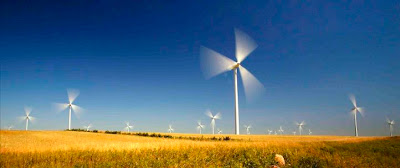By Paul Hanley
The Saskatoon StarPhoenix
December 28, 2010
With Saskatoon looking at putting up its first wind turbine, the contrarians are obliged to step up to the plate. Citing authorities in Denmark, the world centre of wind energy, columnist Bronwyn Eyre for instance reported recently that increased development of wind turbines does not reduce CO2 emissions; that European utilities pay up to 20 times the price of conventional power for renewable power; and that wind power is pretty much useless anyway.
Where do these notions come from? Are they valid? Let's follow the money.
According to the article "Oil industry behind critical wind energy report" in the Copenhagen Post, the source of the these "facts" is a study from the free market Danish think-tank CEPOS that was commissioned and paid for by the Institute for Energy Research (IER), an American organization tied to the coal and oil industries. Apparently, they came up with the report in the lead-up to last year's climate summit in Copenhagen in an effort to forestall the renewable energy industry, hold on to fossil fuel's market share and scuttle meaningful action on climate change.
Renewable energy is not perfect, so if one is intent on finding its faults, magnifying them and ignoring everything positive it's easy to do a hatchet job.
 Eyre contends that wind power's potential is insignificant. "Wind speeds . . . are continually changing and often provide no power at all -- so the electricity being generated represents only between a quarter and a third of their nominal capacity." A 150-megawatt wind power project, for example, only produces that kind of power when it is very windy. True enough.
Eyre contends that wind power's potential is insignificant. "Wind speeds . . . are continually changing and often provide no power at all -- so the electricity being generated represents only between a quarter and a third of their nominal capacity." A 150-megawatt wind power project, for example, only produces that kind of power when it is very windy. True enough. She also says, given the low rate of real power production, "the turbine (proposed) at the (Saskatoon) landfill might just manage to power the weigh scale -- and that's on a windy day."
Reality check: According to SaskPower, the Centennial Wind Power Facility in southwest Saskatchewan boasts a 42.4 per cent capacity factor. The 83 wind turbines produce more than 555 gigawatt-hours of energy a year. This is equivalent to the electricity consumed annually by 69,000 homes. Assuming Saskatoon Light and Power gets somewhat similar results, their one turbine should provide power for about 800 homes, plus the weigh scale.
When Saskatchewan's fourth wind power project is brought into service through the Red Lily Wind Project, wind power will make up about 8.5 per cent of SaskPower's total generating capacity. The expansion of wind power will reduce the corporation's carbon dioxide emissions by approximately 225,000 tonnes per year.
And what of the huge subsides that supposedly make renewable power up to 20 times as expensive as conventional sources. According to Windpower Engineering, the cost of electricity from utility-scale wind turbines has dropped by more than 80 per cent over the last 25 years, from as much as $0.30/kWh to as little as $0.05/kWh.
Wind does receive public subsides, but that is nothing new for fledgling industries. It is nothing new for established industries either: Canadian taxpayers are paying somewhere in the neighbourhood of $2 billion in subsidies to highly profitable oil, gas and coal companies every year. Worldwide, oil subsidies alone are estimated at $667 billion annually, three times the amount invested globally in renewable energy.
As to the countryside, wind energy has a very small footprint and allows farmers and ranchers to continue to use their land, gives them an additional income and can be easily remediated when decommissioned. Compare that to a coal mine.
A final point: Comprehensive studies show no significant health impacts from wind turbine noise with standard setbacks. One report suggested that the power of suggestion, as conveyed by news media coverage of perceived "wind-turbine sickness," might have triggered "anticipatory fear" in those close to turbine installations.
Meanwhile, fossil fuel use threatens the viability of civilization. But that's OK because it's not in my backyard.
Read more: http://www.thestarphoenix.com/technology/still+blowing+wind+power/4031184/story.html#ixzz19TEvpzY6


No comments:
Post a Comment